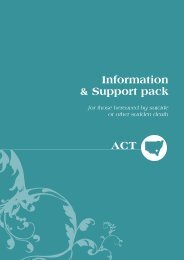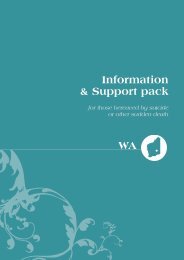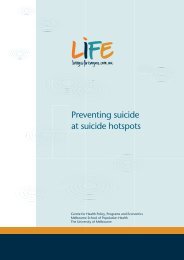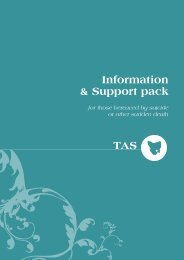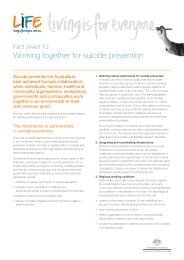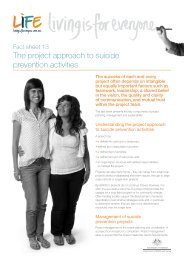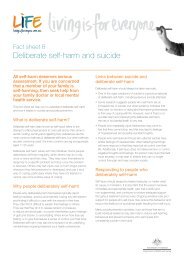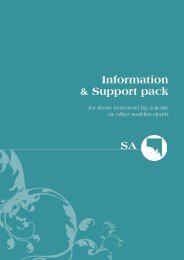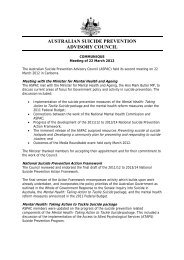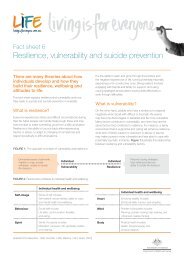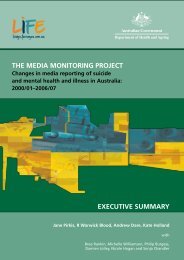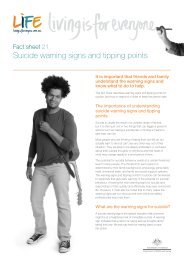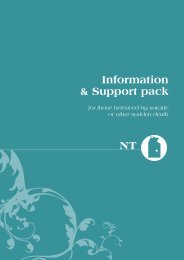SUICIDE in RURAL & REMOTE AREAS of AUSTRALIA - Living is for ...
SUICIDE in RURAL & REMOTE AREAS of AUSTRALIA - Living is for ...
SUICIDE in RURAL & REMOTE AREAS of AUSTRALIA - Living is for ...
Create successful ePaper yourself
Turn your PDF publications into a flip-book with our unique Google optimized e-Paper software.
Suicide <strong>in</strong> rural and remote areas <strong>of</strong> Australia 11<br />
Suicidal Behaviours <strong>in</strong><br />
Australian Farmers<br />
Studies which have looked at the vulnerability <strong>of</strong><br />
rural men to poorer health and wellbe<strong>in</strong>g and their<br />
correspond<strong>in</strong>g higher rates <strong>of</strong> r<strong>is</strong>k-tak<strong>in</strong>g, self-harm<br />
and suicidal behaviours have begun to d<strong>is</strong>sect the<br />
mascul<strong>in</strong><strong>is</strong>t paradigm which frames the perceived<br />
and lived experiences <strong>of</strong> rural Australia – what<br />
rural Australia <strong>is</strong> presumed to be like and how rural<br />
Australia <strong>is</strong> <strong>in</strong> real life (Alston, 2010; Alston & Kent,<br />
2008; Bourke, 2003; Dempsey, 1992; Fraser et<br />
al, 2005; Liep<strong>in</strong>s, 2000). Traditional mascul<strong>in</strong>ity<br />
<strong>is</strong> so closely tied to the construction <strong>of</strong> the rural<br />
‘place’ that agriculture <strong>is</strong> perceived to ‘make’ men<br />
<strong>in</strong> Australia (Liep<strong>in</strong>s, 2000). Rural males are ‘made’<br />
to be physically and emotionally tough and strong,<br />
able to solve any problem as no obstacle can beat<br />
them, where alcohol, sport and (some degree <strong>of</strong>)<br />
physical violence <strong>is</strong> naturally accepted (Alston &<br />
Kent 2008; Bourke, 2003; Dempsey, 1992; Liep<strong>in</strong>s,<br />
2000; Lockie & Bourke, 2001). Th<strong>is</strong> man <strong>is</strong> the hero<br />
<strong>of</strong> rural mythology. Even though he may be unreal,<br />
th<strong>is</strong> construct <strong>is</strong> so normal<strong>is</strong>ed that it cont<strong>in</strong>ues<br />
to impact on the ways <strong>in</strong> which ‘rural’ Australia <strong>is</strong><br />
predom<strong>in</strong>antly presented <strong>in</strong> the media. Traditionally,<br />
these strong mascul<strong>in</strong>e men were expected to take<br />
on leadership roles with<strong>in</strong> their rural community;<br />
these men provided the foundation upon which<br />
rural communities thrived (Alston, 2010; Alston<br />
& Kent, 2008; Liep<strong>in</strong>s, 2000; Lockie & Bourke,<br />
2001). Consequently, fem<strong>in</strong><strong>in</strong>ity became what<br />
was ‘not’ mascul<strong>in</strong>e (Liep<strong>in</strong>s, 2000). Women were<br />
constructed to be subord<strong>in</strong>ate to and rely upon men,<br />
to become wives and mothers; women watched<br />
men dr<strong>in</strong>k alcohol or play sport, they were not<br />
expected to actively participate <strong>in</strong> these activities<br />
(Alston, 2010; Alston & Kent, 2008; Liep<strong>in</strong>s, 2000).<br />
However, at times, th<strong>is</strong> stark del<strong>in</strong>eation between<br />
acceptable mascul<strong>in</strong>e and fem<strong>in</strong><strong>in</strong>e behaviours has<br />
become problematic <strong>for</strong> those men and women who<br />
did not neatly fi t with<strong>in</strong> such bounds. Gay men, or<br />
men who simply chose recreational avenues outside<br />
sport such as the creative arts, can be marg<strong>in</strong>al<strong>is</strong>ed<br />
and abused; women may struggle with education<br />
and employment opportunities which can confl ict<br />
with traditional subord<strong>in</strong>ate roles (Alston & Kent,<br />
2008; Bourke, 2003).<br />
Yet, <strong>in</strong> the wake <strong>of</strong> Australia’s rural cr<strong>is</strong><strong>is</strong> and the<br />
aftermath <strong>of</strong> long-term drought, the del<strong>in</strong>eation<br />
between mascul<strong>in</strong>e/dom<strong>in</strong>ant and fem<strong>in</strong><strong>in</strong>e/<br />
subord<strong>in</strong>ate roles have no longer been able to af<strong>for</strong>d<br />
to be so stark. Research has shown that women are<br />
<strong>in</strong>creas<strong>in</strong>gly employed <strong>in</strong> <strong>of</strong>f-farm work to keep the<br />
farm fi nancially viable (Alston, 2010; Alston & Kent,<br />
2008). Recently, Alston found that “…over 50%<br />
<strong>of</strong> farms run by families are now reliant on <strong>of</strong>f-farm<br />
<strong>in</strong>come to stay <strong>in</strong> farm<strong>in</strong>g and 80% <strong>of</strong> th<strong>is</strong> work <strong>is</strong><br />
done by women” (2010, p. 2). While employment<br />
structures have necessarily changed, other ideals<br />
have not. Women are still <strong>of</strong>ten expected to fulfi l<br />
the duties attached to their traditional role <strong>of</strong> wife/<br />
mother, as well as any on-farm work such as fi nancial<br />
management (Alston, 2010). Further, the reliance<br />
on an <strong>of</strong>f-farm <strong>in</strong>come, brought <strong>in</strong> by a woman, has<br />
arguably had negative impacts on the male sense<br />
<strong>of</strong> self – they are no longer the breadw<strong>in</strong>ner, even<br />
if they are cont<strong>in</strong>u<strong>in</strong>g to con<strong>for</strong>m to all the ideals<br />
<strong>of</strong> the rural mascul<strong>in</strong><strong>is</strong>t paradigm (Alston, 2010;<br />
Fraser et al, 2005; Liep<strong>in</strong>s, 2000). In th<strong>is</strong> way,<br />
“while th<strong>is</strong> hegemonic position has benefi ted men<br />
<strong>in</strong> good times, it also locks them <strong>in</strong>to fairly rigid<br />
subject positions, typifi ed by a stoic res<strong>is</strong>tance to<br />
adversity and a rugged <strong>in</strong>dividual<strong>is</strong>m that prevents<br />
help-seek<strong>in</strong>g behaviour” (Alston & Kent, 2008, p.<br />
136). Men may shoulder the blame <strong>for</strong> any <strong>of</strong> these<br />
GriffithBook FINAL 20/09.<strong>in</strong>dd 11<br />
15/11/12 4:28 PM



